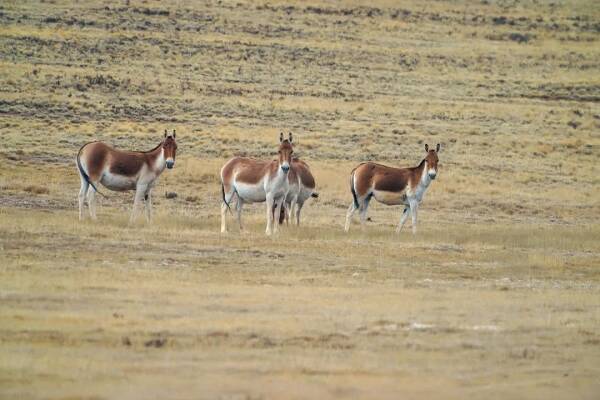Tibetan wild ass kiang) : Translated as "江", the Tibetan wild ass is an animal of the Equidae family and the genus Equus. It is the largest of all wild donkeys, with an average shoulder height of 140 cm. They look like mules, with body shape and hooves much larger than domestic donkeys. They look particularly strong and majestic, so local people often call them "wild horses". National first-level protected animal རྒྱལ་ཁབ་ཀྱི་སྲུང་སྐྱོབ་རིམ་པ་དང་པོའི་སྲ ོག་ཆགས།, a first-level protected animal in the Tibet Autonomous Region བོད་རང་སྐྱོང་ལྗོངས་ཀྱི་སྲུང་སྐྱོ བ་རིམ་ པ་དང་པོའི་སྲོག་ཆགས།.

Basic situation and characteristics
གཞི་རྩའི་གནས་ཚུལ་དང་ཁྱད་ཆོས།
The Tibetan wild ass is an animal of the Equidae family and the genus Equus. It is the largest of all wild donkeys, with an average shoulder height of 140 cm. They look like mules, with body shape and hooves much larger than domestic donkeys. They look particularly strong and majestic, so local people often call them "wild horses".
The Tibetan wild ass can reach more than 2 meters in length, with a short head and long ears. The hair on the body is mainly reddish brown, and the hair color on the chest, abdomen, and limbs is dirty white. The hair color dividing line on the sides of the trunk is obvious, and there is a short and straight dark mane on the neck.
བོད་ལྗོངས་ཀྱི་རྐྱང་ནི་རྟའི་ཚན་ཁག་དང་རྟའི་ དེ་ནི་རི་སྐྱེས་བོང ཆ་སྙོམས་དཔུང་པའི་མཐོ་ཚད་ལ་ལི་རྨིད་140ཡོད། ཁོ ་ཚོའི་ཕྱིའི་གཟུགས་དབྱིབས ་ནི་དྲེལ་དང་འདྲ་ཞིང་། གཟུགས་དབྱིབས་དང་རྨ ིག་པ་ཁྱིམ་གྱི་བོང་བུ་ལས་ཆེ་བ་ཡོད་པས། ཧ་ཅང་ སྟོབས་དང་ ལྡན་པ་མངོན་གྱི་ཡོད། དེས་རྐྱེན་ས་གནས་དེ་ག འི་མི་ཚོས་རྒྱུན་དུ་ཁོ་ཚོར་“རྟ་རྒོད་”ཅེས་འབོ ད་ཀྱི་ཡོད།
བོད་ལྗོངས་ཀྱི་རྐྱང་གི་གཟུགས་པོའི་རིང་ཚད་ལ ་རྨིད་2ལྷག་ཡོད་པ་དང་། རྣ་ལྕོག་ཅུང་རིང ་བ་ཡོད་ ག་གཙོ་བོ་དང་། དོག་ནི་སྐྱ་ བོ་ཡིན། སྒལ་གཞུང་དང་ལྟོ་བའི་མཚམས་ཀྱི་སྤུ་ མཚམས་མངོན་གསལ་དོད་པོ་ཡོད། མཇིང་པའི་མཚམས་སུ་ སྤུ་ཁ་ཐུང་ལ་འདྲོང་ ཞིང་ཅུང་ནག་པའི་རྔོག་ཟེ་ཡོད།
Among all wild donkeys, the Tibetan wild ass is the largest. When it reaches adulthood, the average shoulder height can reach 1.4 meters, the head and body length exceeds 1.8 meters, and the weight can reach 250-400 kilograms. It is a very precious large-scale food in my country. The grass animal is also the largest type of wild ass in my country. Its appearance is similar to the Mongolian wild ass, but it is much larger than the Mongolian wild ass, and its personality is more fierce than the Mongolian wild ass. Compared with most domestic donkeys, the Tibetan wild ass appears to be particularly strong, much like a mule. Its body shape, limbs, and hooves are much thicker than those of the domestic donkey, so the Tibetan wild ass appears to be particularly strong and majestic. But they don't run much like donkeys, more like wild horses. Therefore, in many places, Tibetan wild ass is called "wild horse".
རི་སྐྱེས་བོང་བུ་ཡོད་ཚད་ཁྲོད་ནས་བོད་ལྗོངས་ ཀྱི་རྐྱང་ནི་གཟུགས་བོང་ཆེ་ཤོས་ཀྱི་རིགས་ཤིག ་ཡིན་ཞིང་། ན་སོ 1.4ཟ ིན་ཞིང་། པ་དང་། གཟུགས ་པོའི་ལྗི་ཚད་ལ་སྟོང་ཁེ་250ནས་400བར་ཟིན་གྱི་ཡོ ད། གཟན་སྲོག ་ཆགས་ཆེ་གྲས་ཤིག་ཡིན་ལ། རང་རྒྱལ་གྱི་རྐྱང་ གི་ཁྲོད་ནས་གཟུགས་བོང་ཆེ་ཤོས་ཀྱི་རིགས་ཤིག་ ཀྱང་ཡིན། ཕྱི ་གཟུགས་ནི་སོག་པོའི་རྐྱང་དང་ཆ་འདྲ་ཡང་གཟུགས ་པོ་དེ་ལས་ཆེ་བ་ཡོད་པ་མ་ཟད། རང་གཤིས་ཀྱང་ད ེ་ཚོ ་ལས་གཏུམ་རྒོད་ཆེ་བ་ཡོད། ཁྱིམ་གྱི་བོང་བུ་ ཕལ་ཆེ་བ་དང་བསྡུར་ན་བོད་ཀྱི་རྐྱང་ནི་ཤ་ཤེད་ ཧ་ཅང ་བཟང་བ་ཡོད་པས། དྲེལ་དང་འདྲ་པོ་ཡོད། གཟུགས་ད བྱིབས་དང་རྐང་ལག་བཞི་པོ། རྨིག་པ་བཅས་ཚང་མ་ཁ ྱིམ་ཚང་གི ་བོང་བུ་ལས་ཆེ་ལ་སྦོམ་པ་ཡོད། རྒྱུག་པའི་ཚེ ་ན་བོང་བུ་འདྲ་པོ་མེད་པར་རྟ་རྒོད་དང་འདྲ་པོ ་ཡོད །

Habitat
འཚོ་སྡོད་ཁོར་ཡུག
The environment in which Tibetan wild ass inhabits is generally areas with an altitude of 2,700-5,400 meters. They live at relatively low altitudes in winter, but in summer, they prefer to run to high mountains with an altitude of 5,000 meters. Our county is mainly distributed in Kema, Penji, Jiacuo and other places.
2700 གུན་དུས་མཚོ་ཚད་དམའ ་སར་འཚོ་བ་དང་། དབྱར་དུས་མཚོ་ཚད་5000ཙམ་གྱི་རི ་བོའི་ཁྲོད་འཚོ་སྡོད་བྱེད་ཀྱི་ཡོད། རང་རྫོང་ དུ་གཙོ་བོ་གད་ དམར་དང་ཕན་སྤྱི། ུ་འཚོ་སྡོད་བྱེད་ཀྱི་ཡོད།
Relevant laws
འབྲེལ་ཡོད་ཁྲིམས་སྲོལ།
According to the provisions of Article 341, paragraph 1, of the Criminal Law: Anyone who illegally hunts or kills rare and endangered wild animals under key state protection, or illegally purchases, transports, or sells rare and endangered wild animals under key state protection and their products shall be punished In accordance with the provisions of Paragraph 1 of Article 341 of the Criminal Law, those who commit the crime of endangering rare or endangered wild animals shall be sentenced to fixed-term imprisonment of not more than five years or criminal detention, and shall also be fined; if the circumstances are serious, they shall be sentenced to fixed-term imprisonment of not less than five years but not more than 10 years. He shall also be fined; if the circumstances are particularly serious, he shall be sentenced to fixed-term imprisonment of not less than ten years and shall also be fined or his property shall be confiscated.
《ཉེས་ཁྲིམས》ཨང་341གི་དོན་ཚན་དང་པོའི་ནང་གཏན་འ བེབས་བྱས་པ་གཞིར་བཟུང་། རྒྱལ་ཁབ་ཀྱི་གཙོ་གནད ་སྲུང་སྐྱོབ་བྱེད་ པའི་རྩ་ཆེན་དང་སྟོངས་ལ་ཉེ་བའི་རི་སྐྱེས་སྲོ ག་ཆགས་ཁྲིམས་འགལ་གྱིས་རྔོན་འཛིན་དང་གནོད་འཚ ེ་གཏོང་བའམ། ཡང་ན་ རྒྱལ་ཁབ་ཀྱི་གཙོ་གནད་སྲུང་སྐྱོབ་བྱེད་པའི་ར ྩ་ཆེན་དང་སྟོངས་ལ་ཉེ་བའི་རི་སྐྱེས་སྲོག་ཆགས ་དང་དེ་ལས་བཟོས་པའི་ དངོས་རྫས་རིགས་ཁྲིམས་འགལ་གྱིས་ཉོ་སྒྲུབ་དང་ སྐྱེལ་འདྲེན། ཕྱིར་འཚོང་བཅས་བྱས་ཚེ། ཁྲིམས་ཨང་341གི་དོན་ཚན་དང་ པོའི་ནང་གཏན་འབེབས་བྱས་པ་གཞིར་བཟུང་། རྩ་ཆེ ན་དང་སྟོངས་ཉེའི་རི་སྐྱེས་སྲོག་ཆགས་ལ་གནོད་ག ཚེ་བཏང་བའི་ཉེས་པར་དུས ་བཀག་བཙོན་འཇུག་ལོ་ལྔ་མན་ཆད་ཀྱི་ཉེས་ཆད་སྤྱ ོད་རྒྱུའམ་བཀག་ཉར་བྱེད་རྒྱུ་དང་དུས་མཚུངས་ད ངུལ་ཆད་གཏོང་རྒྱུ། བབ ་རྐྱེན་ཆེ་བའི་རིགས་ལ་ལོ་ལྔ་ཡན་དང་ལོ་བཅུ་མ ན་གྱི་དུས་བཀག་བཙོན་འཇུག་བྱེད་རྒྱུ་དང་དུས་ མཚུངས་དངུལ་ཆད་གཏོང ་རྒྱུ། བབ་རྐྱེན་ཧ་ཅང་ཆེ་བའི་རིགས་ལ་ལོ་བཅུ ་ཡན་གྱི་དུས་བཀག་བཙོན་འཇུག་བྱེད་རྒྱུ་དང་དུ ་མཚུངས་དངུལ་ཆད་དམ ་རྒྱུ་ནོར་གཞུང་བཞེས་གཏོང་རྒྱུ།
animal tags:
We created this article in conjunction with AI technology, then made sure it was fact-checked and edited by a Animals Top editor.